Best Free Presentation Software and Tools
By Alex Carter on October 4, 2024
Presentation software plays a key role in creating visual content for various purposes, including business pitches, educational lectures, and marketing campaigns. The right tool should provide ease of use, customization options, and collaboration features while maintaining compatibility with common file formats.
With many options available, selecting the best software depends on factors such as template availability, design flexibility, sharing capabilities, and cost-effectiveness. Some tools focus on AI-driven automation, allowing for quick content generation, while others emphasize collaborative editing for teams working remotely.
For those looking to enhance visual content beyond presentations, exploring web design tools can help create engaging websites, landing pages, and digital assets.
Key Features of an Effective Presentation App
Choosing the proper presentation software requires emphasizing versatility, since these tools serve a variety of functions, from corporate pitches and product demos to classroom instruction and training sessions. The most effective applications provide:
- Ready-to-Use Templates: Professionally created templates let you produce polished presentations quickly;
- Collaboration and Sharing: Real-time collaboration and simple sharing improve teamwork;
- Customization Options: Advanced editing features enable users to alter slides beyond basic templates;
- Cost Efficiency: A good presenting tool should be affordable, with free choices accessible;
- Independent Operation: The program should function as a stand-alone solution without the requirement for PowerPoint or Google Slides;
- Intuitive Interface: Both novices and expert users will find the familiar slide-based structure easy to use.
Top 10 Presentation Software Options
Canva (Web, Windows, Mac, Android, iOS)
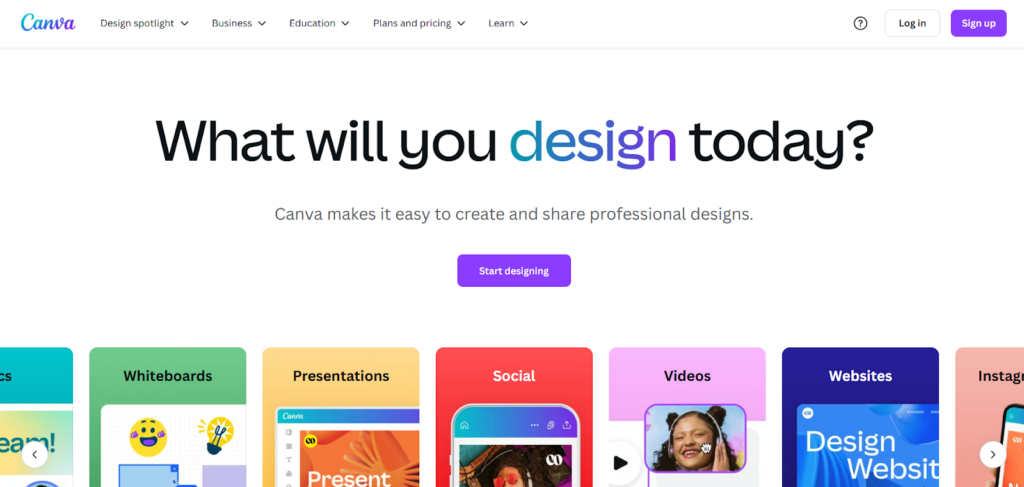
Pros:
- Excellent free plan;
- Extensive collection of high-quality templates for various use cases;
- Feature-rich with numerous design and collaboration tools.
Cons:
- AI-powered tools are not significantly impactful.
Canva offers one of the most comprehensive free plans among presentation software options. Unlike many competitors, the platform allows users to begin creating a presentation immediately, postponing account registration until after the first design is complete. Canva provides a vast selection of visually appealing templates, covering a range of use cases such as business, education, and personal projects, with most available at no cost.
The platform’s intuitive editor eliminates issues like unintended slide transitions due to scrolling, ensuring a smooth editing experience. Users can apply preset animations, incorporate multimedia elements from an extensive library of audio and video files, and share presentations effortlessly through various options, including direct collaboration, social media integration, and QR code sharing.
Canva also enables live presentation features with Canva Live, allowing audience members to submit real-time questions. Presenters can monitor and address these queries within the presenter view window, enhancing engagement. Additionally, presentations can be recorded with a talking-head overlay, and an AI-generated presenter can be utilized for remote sharing.
Although Canva includes AI-powered tools, their effectiveness remains limited. The Magic Design feature, for instance, does not significantly improve upon Canva’s existing selection of pre-designed templates, while Magic Write functions as a rebranded version of ChatGPT. Future updates may enhance these features, but currently, the existing templates offer more value.
Canva provides a free plan with a wide range of templates and design tools. Paid plans start at $120 per year for a single user, offering access to premium features such as the Brand Kit, exclusive templates, stock assets, and additional AI-driven design tools.
Prezi (Web, Mac, Windows, iOS, Android)
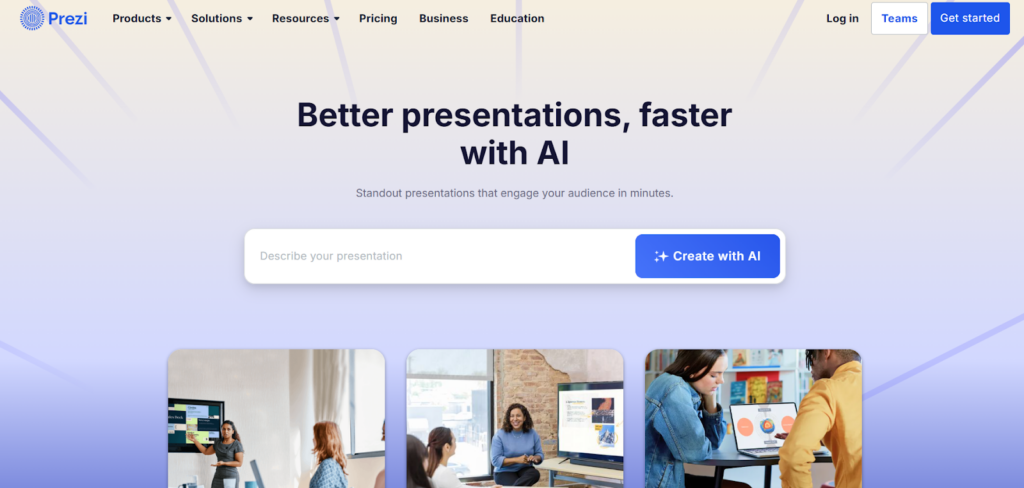
Pros:
- Flexible structure beyond traditional slide-based presentations;
- Extensive customization options;
- Prezi Video allows interactive presentations over webcam feeds.
Cons:
- Steeper learning curve compared to conventional presentation software.
What makes Prezi unique is that it offers a framework based on topics and subtopics rather than the conventional linear slide style. This method facilitates a more conversational and dynamic presentation flow, which makes it simpler to make non-linear connections between concepts.
Despite this unique structure, Prezi retains the core customization features expected from high-quality presentation software. Fully editable templates provide a strong starting point, helping ease the learning curve associated with its innovative format. The platform’s editor simplifies the process, ensuring that users can quickly adapt to this alternative presentation style.
The platform comes with two other capabilities in addition to Prezi Present: Prezi Design and Prezi Video. By superimposing presentation information onto a live camera stream, Prezi Video improves remote presentations. For live presentations, users may include these movies straight into video conferencing apps like Zoom, Microsoft Teams, and Google Meet, or they can be recorded and shared at a later time.
Additionally, Prezi has a generative AI tool that helps with presentation structure. Its skills are very limited, though, producing more general and superficial information than in-depth insights. Although helpful for sketching concepts, more work is frequently required for a polished end result.
Prezi provides a limited-time free plan that allows you to create up to five visual projects, as well as a 14-day free trial. Features like private presentations and complete access to Prezi Present are unlocked with paid subscriptions, which start at $7 per month.
Powtoon (Web, iOS, Android)
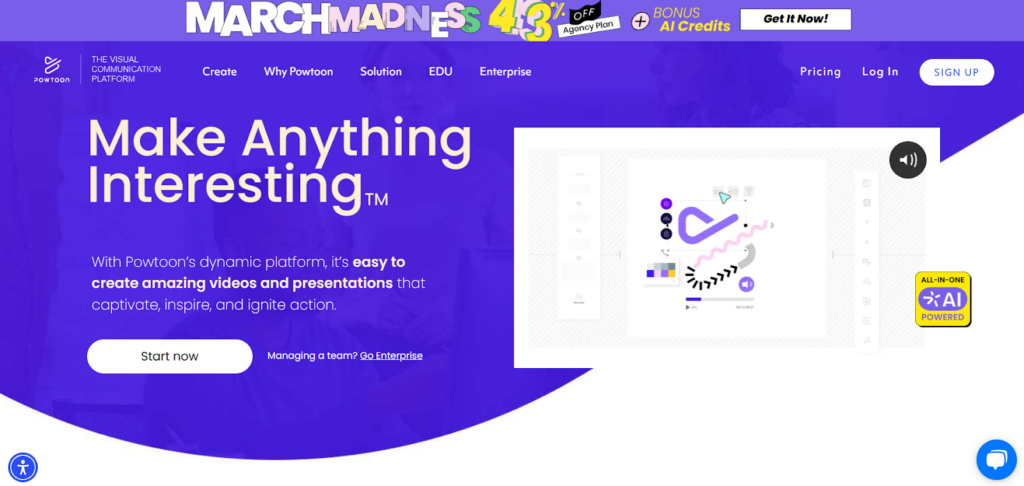
Pros:
- Automatically adjusts timing based on slide content;
- Offers both slideshow and video formats;
- Supports multiple orientations (horizontal, vertical, and square).
Cons:
- Free plan has significant limitations.
Powtoon combines presentation software with animated video creation, using a slide-based editor. Users can edit slides as they would in a traditional presentation, but when played, the result is an animated video. This feature makes it useful for creating explainer videos, marketing presentations, and educational content.
A standout feature of Powtoon is its automated timing adjustments. Each slide’s duration is determined by the amount of content and animations included, with an intuitive time-tracking tool displaying the total duration of the presentation. Users can switch between Slideshow mode (for traditional presentations) and Movie mode (for video playback).
For full functionality, a paid plan is required. The free version imposes restrictions such as a three-minute video limit, MP4 download restrictions, and watermarked branding. Upgrading unlocks a vast library of animated templates, soundtracks, and customization options.
Furthermore, Powtoon provides a variety of aspect ratio choices, enabling users to alternate between square, vertical, and horizontal orientations according to the platform on which the movie will be distributed. Final presentations may be posted straight to Facebook Ads, YouTube, Wistia, and other websites.
Powtoon offers a limited free plan, while paid plans start at $15 per month. Upgraded plans provide access to white-labeling, additional storage, priority support, and more extensive customization features.
Gamma (Web)
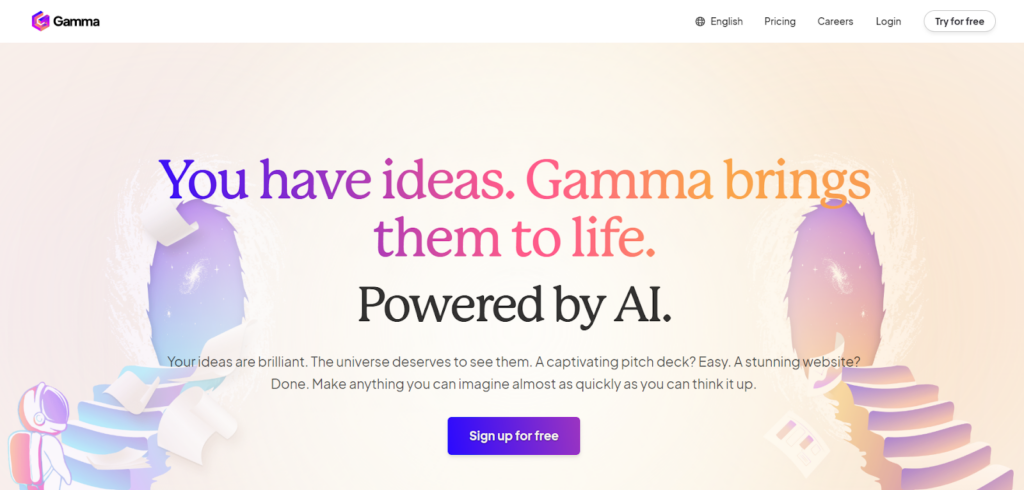
Pros:
- Generates fully developed presentations from a prompt;
- Chatbot-style AI interaction for easy edits;
- Allows for manual adjustments after AI generation.
Cons:
- Limited granular customization.
Gamma stands out among AI-driven presentation tools due to its advanced conversational AI features. Unlike many competitors, Gamma enables users to create a complete presentation simply by providing a topic, uploading an outline, or sharing relevant notes and documents. After approving an AI-generated outline and selecting a theme, the platform automatically builds the entire presentation. While the results may require refinement, Gamma is an effective starting point.
A key differentiator is its chatbot-like editing experience. By selecting Edit with AI, users can interact with Gamma’s chat interface, utilizing suggested prompts or entering custom requests to modify the presentation. Once AI adjustments are complete, manual edits can be made to change layouts, format text, and add multimedia elements, such as images, videos, or embedded web content. While customization options are not as detailed as in traditional presentation software, Gamma integrates AI automation with user control.
Gamma offers a free plan with unlimited users, 400 AI deck credits, and basic analytics. The Plus plan starts at $8 per user per month, unlocking unlimited AI credits, branding removal, and additional features.
Mentimeter (Web)
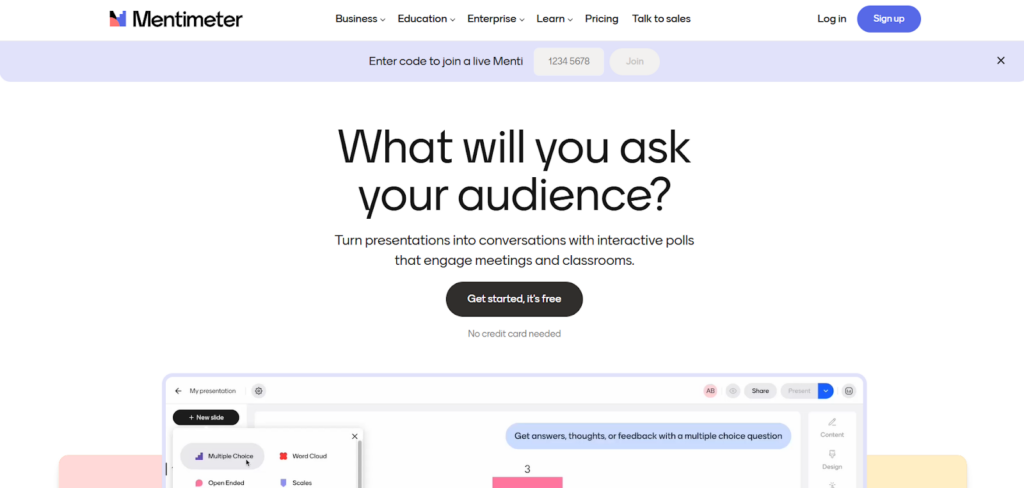
Pros:
- Extensive audience engagement features (quizzes, polls, Q&A, and more);
- Easy for participants to interact via QR codes or access codes.
Cons:
- Limited customization options;
- Learning curve for new users.
Mentimeter is designed for interactive presentations, making it ideal for engaging audiences with live polls, quizzes, surveys, and collaborative tools like a Miro whiteboard. The platform includes professionally designed templates that integrate interactive elements, allowing presenters to create engaging presentations quickly.
Audience participation is made easy with QR codes and access codes, allowing attendees to join the presentation from their smartphones. Unlike some tools that require a new code for each interaction, Mentimeter uses a single access code for the entire session, making it more convenient for both presenters and participants.
While the platform is user-friendly once familiarized, it differs from traditional presentation tools, requiring some adaptation. Additionally, visual customization is more restricted compared to design-focused alternatives.
Mentimeter provides a free plan with 50 participant responses per month and 34 slide types. The Basic plan starts at $11.99 per presenter per month, offering unlimited participants and slides, private presentations, and additional features.
Pitch (Web, Mac, Windows, iOS, Android)
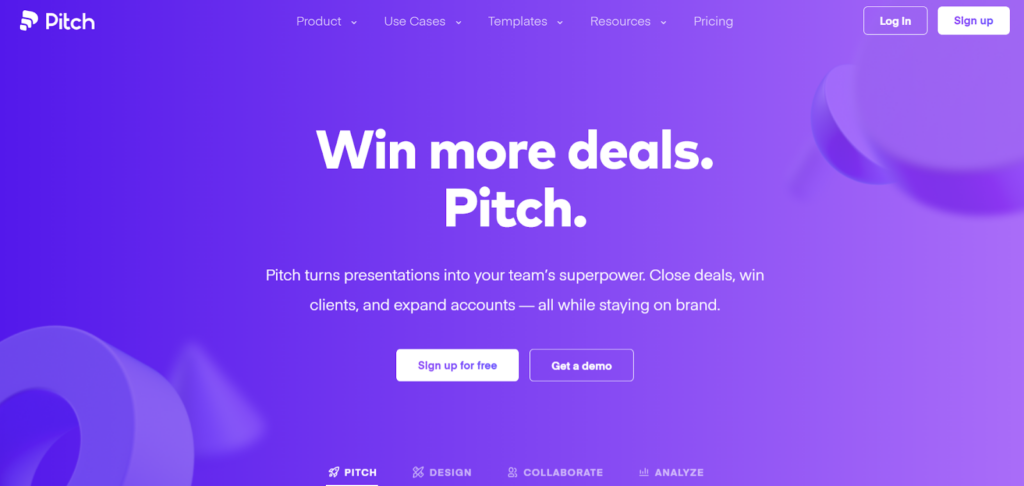
Pros:
- Strong collaboration features, comparable to Google Slides;
- Ability to assign specific slides to team members;
- Advanced generative AI for content creation.
Cons:
- User interface differs from traditional presentation software.
Pitch is a collaboration-focused presentation tool, offering well-designed templates, intuitive customization, and robust team management features. It is an alternative to Google Slides, with additional functionality that enhances team-based workflows.
The right-hand sidebar acts as a project management hub, enabling users to assign slides to team members, track progress, and leave comments or notes. Custom templates can be saved for future use, speeding up the presentation creation process. Additionally, external collaborators can be invited to contribute to specific decks.
For users on paid plans, Pitch enhances team collaboration with workspace roles, shared private folders, and version history tracking.
Pitch also includes a generative AI tool for slide content and design. While AI-generated images may not always be relevant, text-based content and layouts are well-structured and professional.
Pitch offers a free plan with unlimited presentations, custom templates, and live video collaboration. Paid plans start at $22 per month for two users, unlocking workspace features, presentation analytics, and enhanced collaboration tools.
Tome (Web)
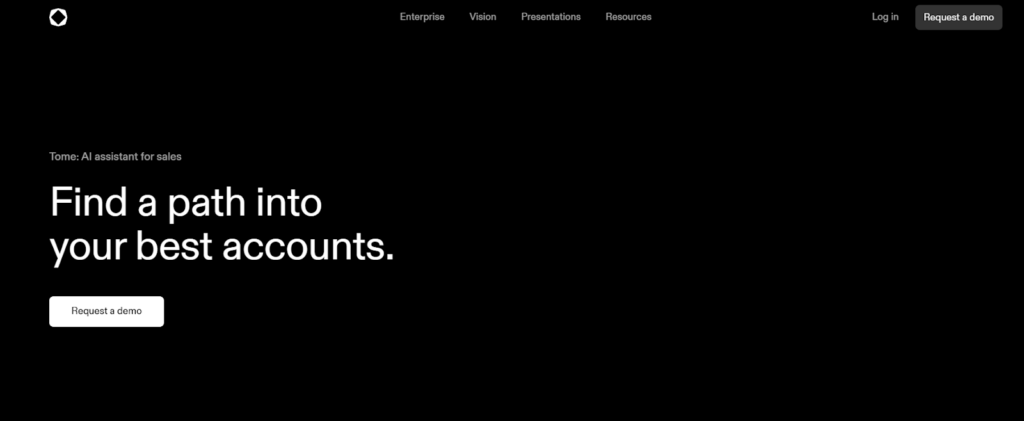
Pros:
- Advanced generative AI capabilities;
- Simple and customizable templates;
- Intuitive document-style editor.
Cons:
- Requires some time to learn the interface.
Tome takes a different approach to AI-powered presentation creation, blending a traditional slide editor with a Notion-style document interface. Its simple layout allows users to quickly generate, edit, and present slides while using AI to assist with content creation.
To create an AI-generated deck, users can click “Generate with AI”, enter a custom prompt, or select from pre-defined prompts suited for use cases such as sales enablement, company pitches, and business proposals. After approving or modifying the suggested outline, the platform automatically generates a complete presentation.
Unlike many presentation tools, Tome’s slides work more like an editable document, allowing users to add as much text and content as needed. The editor supports text formatting, media embedding, and slide resizing without the limitations of a traditional slide deck. This setup provides more control over content and presentation layout.
Tome offers a free plan that allows manual slide creation and editing without AI assistance. The Professional plan starts at $16 per user per month, unlocking AI-powered design tools, engagement analytics, branding customization, and more.
LibreOffice (Mac, Android)
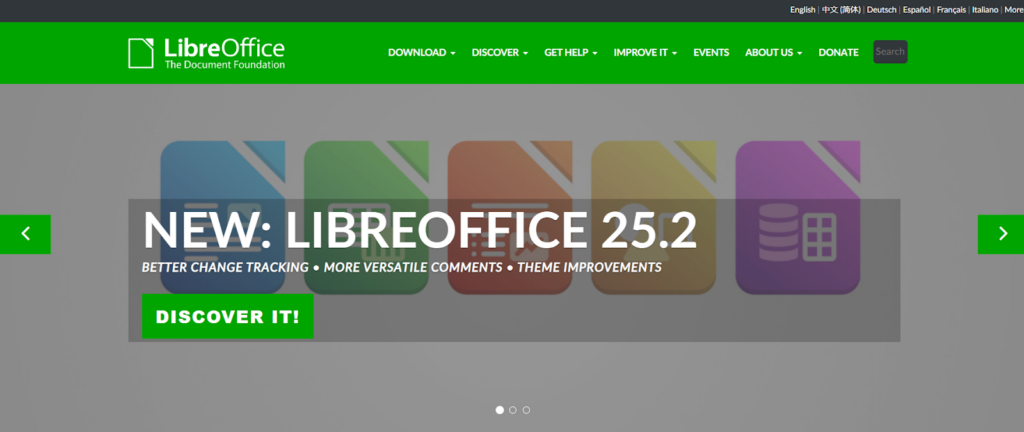
Pros:
- Provides nearly all the functionality of Microsoft PowerPoint;
- Supports file imports from Apple Keynote;
- Access to hundreds of free templates.
Cons:
- Lacks built-in collaboration tools.
LibreOffice Impress is a free alternative to Microsoft PowerPoint, offering a comprehensive set of tools for creating and editing presentations. It includes nearly all of PowerPoint’s core functionalities, making it a viable option for users looking for an offline, open-source presentation tool.
While it does not feature real-time collaboration or cloud integration with platforms like Microsoft OneDrive, Impress offers several advantages, such as compatibility with Apple Keynote files and a vast library of free templates. Additionally, it provides full font customization, removing restrictions that are often present in proprietary software like PowerPoint.
For users seeking a cost-free solution with extensive customization options, LibreOffice Impress delivers a familiar slideshow-building experience without subscription fees.
WPS Office Free (Web, Mac, Windows, iOS, Android)

Pros:
- Large selection of included templates;
- Familiar user interface for Microsoft Office users;
- Extensive animation, transition, and multimedia features.
Cons:
- Advertisements can be distracting.
WPS Office Free functions similarly to Microsoft Office and maintains full compatibility with PowerPoint files without formatting issues during import. The WPS Presentation tool includes animations, slide transitions, content effects, and video embedding, making it a strong free alternative.
The interface is familiar to PowerPoint users, with a ribbon-style toolbar and a slide navigation pane on the left side of the screen. This layout provides easy access to all essential tools, allowing for efficient editing. Presentations can be run directly from WPS Presentation, minimizing the risk of display issues.
The software includes a wide range of features but is supported by ads, which some users may find distracting. However, these ads do not significantly affect functionality.
Google Slides (Web, Windows, iOS, Android)
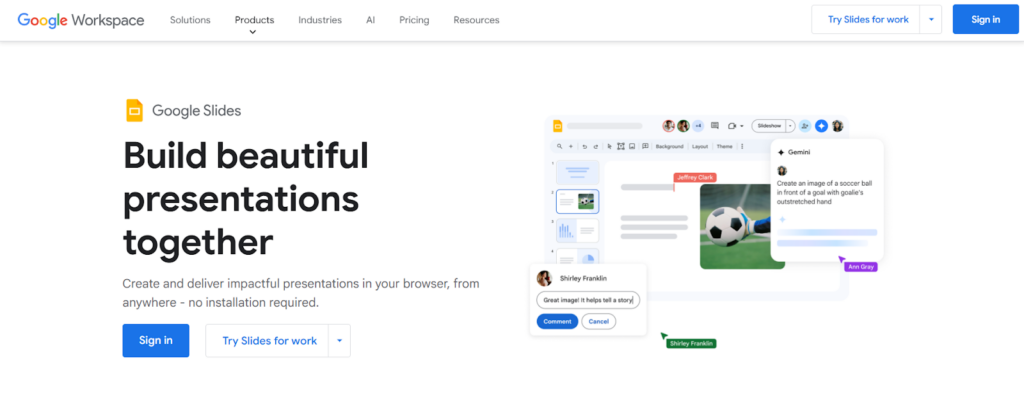
Pros:
- Supports importing third-party templates;
- Built-in collaboration tools with real-time chat;
- Presenter mode for rehearsal and audience preview.
Cons:
- Limited default template selection.
Formatting inconsistencies when converting between Google Slides and PowerPoint
Google Slides, part of Google Workspace, provides a free, cloud-based alternative to traditional presentation software. It offers essential features such as video embedding, diagram creation, and slide animations. While the built-in template selection is limited, users can import external templates or design custom layouts.
Collaboration is one of Google Slides’ strongest features. Multiple users can edit a presentation simultaneously, with real-time chat available to coordinate changes. The presenter mode allows speakers to preview slides, rehearse timing, and manage audience engagement during live presentations.
One drawback is that large or complex slideshows may experience lag, especially when working with embedded media. Additionally, file conversions between Google Slides and PowerPoint can sometimes result in formatting discrepancies, requiring manual adjustments.
Conclusion
Selecting the right presentation software depends on individual needs, whether for professional, academic, or personal use. Some tools prioritize AI-driven automation, while others focus on collaborative editing or visual customization. Free options provide essential features, while premium plans offer advanced functionality, such as branding tools, analytics, and AI-generated content.
When choosing a presentation tool, key considerations include template availability, ease of use, collaboration features, and pricing. Some platforms integrate with cloud storage and third-party applications, while others function as standalone solutions. Evaluating these factors helps in selecting the most suitable software for creating effective and visually engaging presentations.
Posted in blog, Web Applications
Alex Carter
Alex Carter is a cybersecurity enthusiast and tech writer with a passion for online privacy, website performance, and digital security. With years of experience in web monitoring and threat prevention, Alex simplifies complex topics to help businesses and developers safeguard their online presence. When not exploring the latest in cybersecurity, Alex enjoys testing new tech tools and sharing insights on best practices for a secure web.
